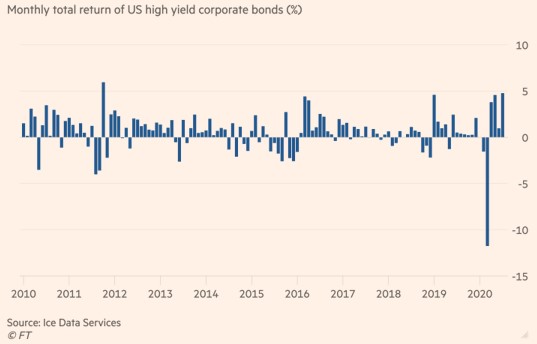 |
Fifty-four companies defaulted on their debts in the second quarter of 2020. That was the most for any three-month period since 2009 in the wake of the Great Recession.
It gets worse. The default wave isn’t anywhere close to cresting.
Moody’s predicts defaults will get worse through 2021. Why? More debt than ever before was ALREADY low-rated and lousy even before the COVID-19 outbreak struck.
And this credit crisis is much more broad-based than anything we’ve ever seen. Retailers and consumer services firms, for instance, are dropping like flies due to plunging in-store sales and crushing debt levels.
Knowing all that, what do you think high-yield “junk” bonds should be doing?
Plunging in price, right?
And investors owning this kind of lousy paper — or mutual funds and ETFs stuffed to the gills with it — would be losing money hand over first, correct?
That’s not what’s happening at all!
In fact, junk bonds just had their best month since October 2011.
 |
A combination of falling interest rates and falling credit risk premiums drove prices up by almost 5% last month.
Is this unusual? You bet it is!
Bank of America (NYSE: BAC, Rated “C”) analysts said the speed and character of this rally is unlike anything seen in the last four decades. There is literally NO precedent for corporate credit distortions of this magnitude.
But it’s easy to understand WHY this is happening: The Federal Reserve is buying and backstopping corporate bonds. And not just top-tier, highly rated, investment grade bonds. Junk bonds, too.
Does that make any sense? Should the Fed be intervening in yet another corner of the market? One in which investors who take on too much risk in search of yield deserve to profit when things go right — but also deserve to lose money when they don’t?
Especially when backstops encourage investors and companies to keep doing dumb things? Like lend or borrow too much money in the future because the consequences were buried under a mountain of Fed money in the past?
Or when it “Zombi-fies” the economy by keeping companies that should die off shuffling around for years on the brink of failure? In fact, a recent Deutsche Bank (NYSE: DB, Rated “D”) analysis characterized one out of every five public U.S. companies as “zombies” — double the level in the early 2010s.
These firms are buried in debt. They’re unable to make enough money to cover payments. But they’re still able to survive on the brink of failure because ultra-low interest rates and more-generous-than-they-should-be borrowing terms are keeping their heads (barely) above water.
I think the answer is pretty obvious.
It’s bad policy that results in bad outcomes for the economy. It also spurs investors to buy bad funds and bad securities at a bad point in the credit cycle.
So, what should YOU do instead? Don’t try to “short” propped up junk paper — for now at least. But don’t buy it, either.
Focus on higher-quality, higher-rated bonds and income-generating “Safe Money” stocks instead. These companies don’t need a Fed handout. And their shares are doing great on their own!
Don’t miss out on alternative assets like gold, silver and mining shares either. They’re crushing the markets due to several powerful and durable forces.
Also recognize that zombification of the economy leads to other, long-term consequences. In Japan, for instance, it helped hollow banks out from within ... while driving long-term interest rates ever lower ... over a span of several years.
That’s why I STILL recommend you stay the heck away from most stocks in vulnerable sectors like financials. The group has been underperforming like crazy since 2018.
It’s also one reason why I believe long-term Treasury prices will rise, while yields will fall toward 0%. That means you can own longer-term bond ETFs for capital gains as well as (admittedly meager) income.
Until next time,
Mike Larson
P.S. — We’re witnessing some the greatest investment opportunities of all time, as one tech stock after another takes off like a rocket — even amid the worst economic downturn in generations.
But not all tech stocks are winners. And that’s where Weiss Ratings comes in. In his recently released FUTURE SHOCK 2020 summit, Dr. Martin Weiss reveals the details of our Future Shock Strategy, used by our tech guru Jon Markman to see ridiculous gains.
If you haven’t seen it yet, you can watch it here. But fair warning: This video summit contains extremely time-sensitive information, and it will be taken down soon.
So, if you’re interested, I recommend you watch it now.

